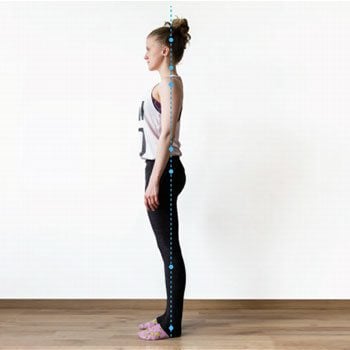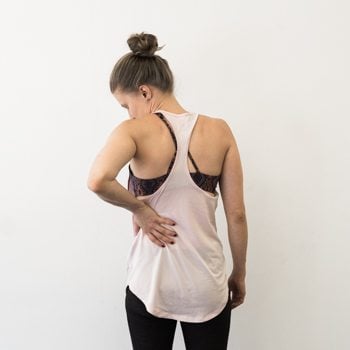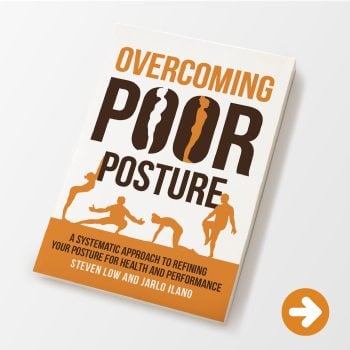Stand up straight! Stop slouching! Most of us have had that yelled at us since we were kids by well meaning (and some not so well meaning) adults.
And did all that childhood trauma result in perfect posture? Probably not.
 And though certainly a more annoying admonition as we get older, it seems difficult to disagree that “standing up tall” is good for us. There’s a strong market out there devoted to various devices, straps, and apps purporting to help you improve your posture.
And though certainly a more annoying admonition as we get older, it seems difficult to disagree that “standing up tall” is good for us. There’s a strong market out there devoted to various devices, straps, and apps purporting to help you improve your posture.
Because frankly, it just looks better!
Whether from thousands of years of social norms or other deep seated genetic factors, tall and straight forms are perceived to be better than a bent and slouched structure.
⏱ In a hurry? Skip to the exercises 🙂
But is it really necessary? Will it help us feel better, be more successful, healthier, and make us more attractive?
The answer, like for most complicated issues, is both yes and no.
Let’s start by going over the fundamental benefits that we know are associated with what’s considered to be “good posture,” along with the myths and misinformation out there, and then give some tips on how to figure out what you need for yourself.
Primary Benefits of Good Posture
Aside from the fact that upright and plumb posture is more aesthetically appealing, there is a lot of evidence for the physiological and mental benefits of a good posture.
Physiological and Mental Benefits
 This was touted several years ago in the popular press as the “Power Posture,” where the various research indicated such benefits as:
This was touted several years ago in the popular press as the “Power Posture,” where the various research indicated such benefits as:
- Inducing feelings of being more powerful
- Improved self-ratings of confidence and ability
- Being perceived as more competent and attractive by observers
- Increased hormone levels (specifically, testosterone)
And though there has been controversy about some of the research, standing taller does seem to effect mental and physiological benefits in general.
Sport-Specific Benefits
 Better aligned posture is also beneficial for active movements.
Better aligned posture is also beneficial for active movements.
An obvious example is lifting overhead. When you are slumped forward, it’s simply harder to lift your arms up, let alone a heavy weight. An elevated chest and pulled back shoulders puts you in a better position to transfer your strength and power more directly to the load.
This is why there is so much time and energy placed on proper technique in sports training.
Through years of experience and research, there’s been a quest towards the ideal form for throwing a baseball, hitting a golf ball, and lifting weights. Postural alignment is a key component for all of these movements.
Posture Mythbusting
So yes, there are a number of good proven reasons to work on your posture, that could have an immediate impact on feeling and moving better. However there are also some myths out there that we should discuss to make sure that you won’t be disappointed by the outcomes of your time and effort.
Myth #1: Everyone should aim for “ideal” posture
 The first myth is that there is an ideal and optimal posture that everyone should conform to.
The first myth is that there is an ideal and optimal posture that everyone should conform to.
You can see this in a variety of sources which attempt to force a rigid positioning. A classic example is military posture, with the chest puffed out and chin tucked into the extreme, at-attention position.
And there are others (usually trademarked and with their own zealots) that purport to have justifications for their brand of posture and advocate very specific details to conform. They may stress precise angles of your spine and shoulder positioning and have their own reasoning for such, but there is no evidence that there is a set position that everyone should be in for optimal health and performance.
Our bodies are dynamic systems that can adapt well to a variety of environments, and in spite of the very many individual anatomical differences that abound, you’ll see very healthy and high performing people of distinct body types and postures.
Myth #2: Slouching = Pain
 Another myth (related to the first myth) is that, if you are not in the “correct” posture, you will inevitably have pain.
Another myth (related to the first myth) is that, if you are not in the “correct” posture, you will inevitably have pain.
But particular postures do not directly equate to pain. If it did, everyone that regularly slouches would have pain, and everyone that tends to stand straight would not. And this, of course, is not true at all.
The existence of pain (particularly chronic) is very complex and involves interrelated factors (anatomy, personal history, emotional makeup, environment), and with regards to postural factors, it’s more of a matter of abrupt change and our capacity for resilience than a particular posture itself.
Any posture that we cannot sustain because of a lack of muscular endurance and/or flexibility can result in pain, whereas another person may be able to because they have a more robust capacity for it. If you aren’t used to standing for more than a couple of hours at a time, you’ll likely experience soreness when you first have to do 8 hours of it, even if in the most perfectly aligned posture possible.
Let’s not force ourselves into holding specific positions because it’s “good for us.” That’s a recipe for burnout and really confers no significant benefit.
Instead, it’s much better to take the lessons we learn from analyzing our particular deficiencies. What do we need to work on to improve our ability to get into and maintain good alignments for our daily lives and in our recreational activities? This matters much more than working toward an arbitrary “ideal” posture that may or may not be appropriate for our individual needs.
Posture is a Habit
 Clearly, posture isn’t as cut-and-dried as simply “standing up straight.”
Clearly, posture isn’t as cut-and-dried as simply “standing up straight.”
Posture is important and necessary, but there’s no universal ideal that works for everyone. It’s a matter of working to attain the posture that’s most advantageous for you.
We can design the best exercise program, targeting your personal strength, flexibility, and control deficits, but if you default to problematic postures for the rest of your day, then the benefits won’t be fully realized.
But changing postural habits is a difficult thing, and can take a long time. It requires a lot of patience and a understanding of personal motivations and dispositions, and it can never be as simple as yelling at yourself to stand up taller and quit slumping!
As you can see, we feel the topic of posture and changing it is much more nuanced than it can appear to be on the surface. We most always recommend working on your strength and mobility if you want to ‘fix’ your posture.
There are physical, mental, and habitual shifts that need to occur to make sustainable changes in your life. But it is well worth it because postural change can be a vehicle for insight into your personal strength, mobility, and habit detriments, and this can affect the entirety of your being.
So What Can You Do to Improve Your Posture?
 Posture is a pretty complex subject, and one we can’t cover in near enough detail within an article like this. But if you want to work on improving your posture for your own needs, you’re in luck.
Posture is a pretty complex subject, and one we can’t cover in near enough detail within an article like this. But if you want to work on improving your posture for your own needs, you’re in luck.
Steven Low, author of the bestselling and most comprehensive bodyweight exercise training tome, Overcoming Gravity, reached out to us to collaborate on his new posture book. We, of course, accepted with great excitement.
Our philosophies on posture and movement fit well together and the result is Overcoming Poor Posture.
5 Quick Posture Exercises from Overcoming Poor Posture
You can see that these exercises cover a lot of ground, and by making them part of your regular routine, you’ll also be brining more awareness to your posture throughout the day, which is one of the best ways to improve your habitual postures.
And when you’re ready to dig deeper into the how and why, pick up the book:
Overcome Your Poor Posture
Our new book, Overcoming Poor Posture, provides a systematic approach to improving how you stand and move, which will help you in all your endeavors.







